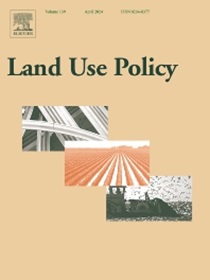Complex interactions of ecosystem services and their dynamic changes in response to land-use conflicts—A network analysis in the Yangtze River Economic Belt, China
IF 6
1区 社会学
Q1 ENVIRONMENTAL STUDIES
引用次数: 0
Abstract
The complex interactions of ecosystem services (ESs) are relevant to human well-being, while land-use conflicts affect the stability of these interactions. Despite their importance, current research offers limited insights into the dynamic variations of ES interactions and how they evolve in response to land-use conflicts. In this study, we constructed correlation networks to analyze the evolution of six ESs in the Yangtze River Economic Belt (YREB) from 2000 to 2020, including habitat quality (HQ), climate regulation (CR), soil conservation (SC), carbon sequestration (CS), and food yield (FY). We also quantified the land-use conflict strength (LUCS) and applied a generalized additive model to investigate how these interactions change in response to land-use conflicts. The results showed that the network structure tended to loosen over time, with a gradual decline in interaction connectivity. FY dominated the trade-off networks, while HQ, CS, and SC were central in the synergy networks. ES interactions exhibited nonlinear effects as LUCS increased: initially, ESs experienced coupling, followed by a decoupling phase. At weak and relatively weak LUCS, ESs displayed strong positive or negative connections. However, once LUCS surpassed a certain threshold, these connections rapidly weakened, and the services formed isolated synergistic clusters. These findings enhance our understanding of land-use dynamics and provide valuable insights for promoting rational land-use planning and achieving synergistic management of ESs.
长江经济带土地利用冲突下生态系统服务功能的复杂相互作用及其动态变化——基于网络的分析
生态系统服务之间复杂的相互作用关系到人类福祉,而土地利用冲突影响着这些相互作用的稳定性。尽管它们很重要,但目前的研究对ES相互作用的动态变化以及它们如何响应土地使用冲突的演变提供了有限的见解。本文通过构建相关网络,分析了2000 - 2020年长江经济带6个生态系统(生境质量(HQ)、气候调节(CR)、土壤保持(SC)、固碳(CS)和粮食产量(FY))的演变。我们还量化了土地利用冲突强度(LUCS),并应用广义加性模型来研究这些相互作用如何随着土地利用冲突而变化。结果表明,随着时间的推移,网络结构趋于松弛,交互连通性逐渐下降。FY在权衡网络中占主导地位,而总部、CS和SC在协同网络中占中心地位。随着LUCS的增加,ES相互作用表现出非线性效应:最初,ES经历耦合,随后是解耦阶段。在较弱和相对较弱的LUCS下,ESs表现出较强的正相关或负相关。然而,一旦LUCS超过一定阈值,这些联系就会迅速减弱,形成孤立的协同集群。这些研究结果增强了我们对土地利用动态的认识,为促进土地利用的合理规划和实现生态系统的协同管理提供了有价值的见解。
本文章由计算机程序翻译,如有差异,请以英文原文为准。
求助全文
约1分钟内获得全文
求助全文
来源期刊

Land Use Policy
ENVIRONMENTAL STUDIES-
CiteScore
13.70
自引率
8.50%
发文量
553
期刊介绍:
Land Use Policy is an international and interdisciplinary journal concerned with the social, economic, political, legal, physical and planning aspects of urban and rural land use.
Land Use Policy examines issues in geography, agriculture, forestry, irrigation, environmental conservation, housing, urban development and transport in both developed and developing countries through major refereed articles and shorter viewpoint pieces.
 求助内容:
求助内容: 应助结果提醒方式:
应助结果提醒方式:


